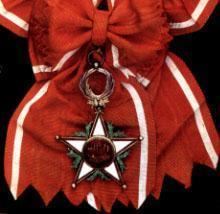Royal house Alaouite Status Currently constituted | Sovereign King Mohammed VI | |
 | ||
Awarded for Displaying heroism in combat or contributing meritorious service to the Moroccan state Grades Knight Grand Cordon with CollarKnight Grand CordonKnight Grand OfficerKnight CommanderKnight OfficerKnight | ||
The Order of Ouissam Alaouite or the Sharifian Order of Al-Alaoui is a military decoration of Morocco which is bestowed by the King of Morocco upon those civilians and military officers who have displayed heroism in combat or have contributed meritorious service to the Moroccan state. The decoration was established on 11 January 1913 in replacement of the Order of Ouissam Hafidien. It is awarded in five classes: Grand Cross (Grand Croix), Grand Officer (Grand Officier), Commander (Commandeur), Officer (Officier) and Knight (Chevalier).
Contents
The Order of Ouissam Alaouite is similar to the Legion of Merit, awarded by the United States military.
History
The order of Ouissam Alaouite was created during the colonial period. The French authorities in Morocco considered it necessary to have the power to bestow an official honour or decoration in response to loyal service; and they wanted to avoid over-burdening the bureaucracy of the order of the Légion d'Honneur in Paris. The ribbon of the order during this period was a shade of orange or pumpkin-coloured. In 1934, a white stripe was added on each side of the ribbon.
During the Second World War, the Order of Ouissam Alaouite was bestowed frequently on United States military personnel who had participated in the planning and execution of Operation Torch, the invasion of French Morocco. Morocco was a protectorate of France from 1912 to 1956, and the decoration was bestowed frequently on French military officers during that period.
After Moroccan independence in 1956, the Alawid Order became a prerogative of the Alawid King and his heirs. The Order continues through the present day, the original medal and the 1934's ribbon unchanged.
Selected recipients
1943 ceremony
In the opening scene of the film Patton, George C. Scott, portraying then-Major General Patton, is shown receiving the Grand Cross of the Order of Ouissam Alaouite. This was no mere Hollywood contrivance. Under Patton's command, Allied forces took Casablanca after only four days of fighting. So impressed was the Sultan of Morocco that he presented Patton with the special Order of Ouissam Alaouite, with the citation: "Les Lions dans leurs tanières tremblent en le voyant approcher" (The lions in their dens tremble at his approach). Patton wryly described the ceremony as a "non-military activity," but in his memoirs, he does not fail to note the Operation Torch staff officers who were similarly honored on that occasion.
